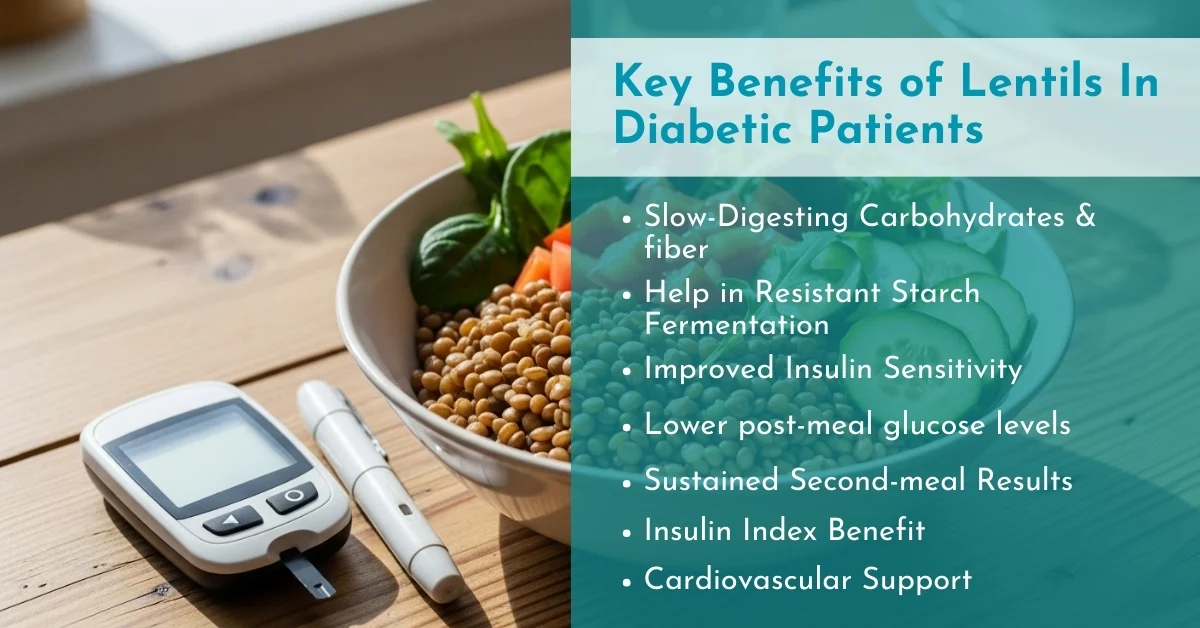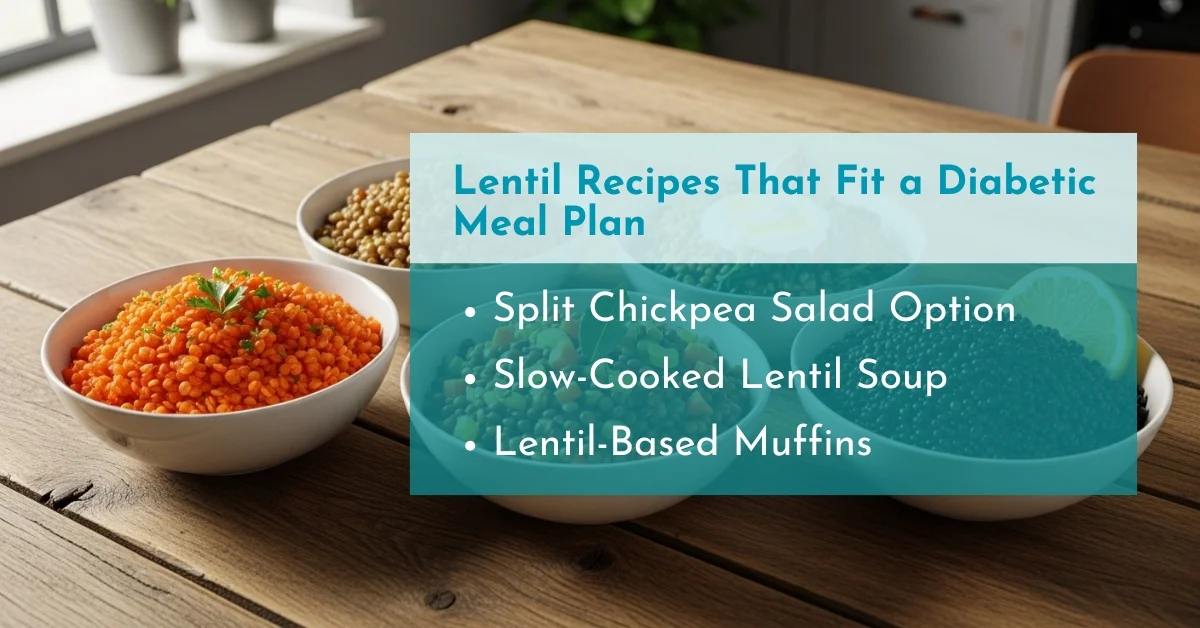No products in the cart.
Are Lentils Good for Diabetics? How They Lower Blood Sugar
Originating from Middle Eastern cuisine, lentils have been shown in studies to significantly reduce post-meal blood sugar and insulin spikes—by up to 56.5% in healthy individuals and 31% in people with diabetes When people ask, “Are lentils good for diabetics?” The answer is always”yes,” whether you have type 1 or Type 2 diabetes.
Lentils can help improve insulin sensitivity because they’re low on the glycemic index and packed with plant-based protein and fiber, making them a smart choice for people with diabetes. If you’d like to see how lentils affect your blood sugar in real time,
This post covers comparing lentils to other legumes, exploring science-backed benefits, offering delicious lentil recipes for diabetics, all aimed at helping you build a whole food, diabetic-friendly diet.
What Are Lentils and Their Nutritional Profile
Lentils are a godsend natural diet item for blood sugar control. One cooked cup (≈198 g) offers a powerful nutritional lineup of:
- 9g protein (extra powerful as it’s plant-based and diabetes-friendly)
- 15g fiber (fiber-rich food that supports gut health)
- 20g carbs (low-GI and slow-digesting carbohydrates)
- High in magnesium, iron, folate, phosphorus and polyphenols (From brown and green to black, red, moong and daal)
- It has 5 percent resistant starch, which transforms into short-chain fatty acids (SCFAs) and helps improve digestion and glucose metabolism.
In addition to all of the above nutrients, they don’t trigger an insulin spike as other starchy food items (i.e. white rice and potatoes etc. ). Their slow energy release may lower blood sugar levels following meals, making them an ideal food choice for people suffering from diabetes.
Glycemic Index of Lentils: Why It Matters
Lentils are one of the natural and organic low glycemic index (GI) foods. They can be added to the diets of individuals managing type 2 diabetes or insulin resistance. They are carbs, but they are not high-GI carbohydrates, so no worrying about the so-called rapid glucose elevation. Lentils digest slowly, helping to stabilize post-meal blood sugar levels.
Even cooked lentils generally fall between GI 10-30, with most varieties around GI 22-25 only. This places them well within the low glycemic index food range (≤ 55), and their glycemic load (GL) remains low, averaging 7 per cooked cup.
This is why it’s important in the regulation of blood sugar:
• Low Glycemic Level (GL)
The total impact on blood sugar is very low, even with an entire serving. The high fiber and resistant starch content of lentils enables glucose to be released gradually into the bloodstream, slowing the rise of blood sugar levels. This makes them a great option for maintaining energy levels throughout the day and minimizing hunger.
• Better Insulin Response
Clinical trials have shown that lentils can increase glycemic control and decrease the demand for insulin. In addition, lentils aid in improving bioactive compounds such as polyphenols that help provide further support for insulin responsiveness and protect pancreatic function over time, increasing their effectiveness.
• Type 2 diabetes support:
Regular consumption of foods with low-GI can improve A1C-related outcomes. Incorporating lentils into the diet can help control weight, manage type 2 diabetes or cardiovascular risks, and enhance metabolic health. Furthermore, the high protein and fiber of lentils, which promote satiety, portion control, and calorie-restricted diets, can aid in achieving better weight loss and managing diabetes.
• Low Glycemic Index (GI)
This slows digestion, which can delay glucose absorption, and reduces postprandial spikes. The gradual increase of glucose reduces spikes and drops in blood sugar levels, which helps energy and mood remain steady. In addition, the insulin-resistant and inflammatory response protective properties of lentils slow down glucose absorption due to the soluble fiber, bolstering gut health.
| Food | GI Score |
| Lentils, red split | 21 |
| Lentils, green | 22 |
| Kidney beans | 23 |
| Chickpeas | 33 |
| Oatmeal (rolled) | 58 |
| White bread | 76 |
| White rice | 89 |
| Skinless potato | 98 |
Note!
You want to know how this will affect you personally? Eat and then monitor your blood sugar levels. For precise blood sugar feedback, use FreeStyle Libre 3 Plus to measure before and after meals.
How Lentils Help Manage Blood Sugar
Lentils support blood sugar treatments through multiple clinically backed mechanisms. Their metabolic benefits apply both immediately post-meal and across the day. It’s so advantageous for Type 2 diabetes that it’s known as the second meal effect.
Key Benefits of Lentils In Diabetic Patients

1. Slow-Digesting Carbohydrates & fiber
The soluble and insoluble fibre matrix in lentils delays gastric emptying and carbohydrate absorption. It reduces the chances of blood sugar spikes after meals
2. Resistant Starch Fermentation
As covered above, lentils ferment the colon to produce SCFAs that improve insulin signalling and gut health, which are more crucial.
3. Improved Insulin Sensitivity
An 8-week RCT found that daily lentil intake means better insulin sensitivity. It’s a great food that reduces insulin resistance without gastrointestinal complaints
4. Lower post-meal glucose levels and insulin
Rapid clinical trials consistently demonstrate that lentils reduce postprandial insulin and glucose greater than starchy counterparts.
5. Sustained Second-meal Result
Lentils improve glycemic control not just during the initial meal, but they also lessen the impact of glycemia at the following meal and reduce the burden of cumulative glucose
6. Insulin Index Benefit
Lentils have an extremely moderate index of insulin, which means they trigger less release of insulin than foods with high carbs. This helps to achieve greater insulin sensitivity and decreases metabolic stress.
7. Cardiovascular Support
Lentils can reduce cholesterol levels in the LDL range and help maintain good blood pressure, which reduces the risk of heart disease in people with diabetes. The fiber content of their high-fibre diet binds to cholesterol and bile acids, which aids in excretion, improves the lipid profile and lowers blood sugar post-meal. Source: NCBI
Lentils vs. Beans & Other Legumes (For Diabetics)
| Food | GI Score | Protein (½ cup) | Fiber (½ cup) | Notes |
| Lentils | 22–30 (Low) | ~9g | ~8g | Fast-cooking, good balance of protein + fiber |
| Beans | ~28–55 (Low) | ~7-8g | ~7-9g | Great for variety; slightly higher GI |
| Chana Dal | ~8 (Very Low) | ~8g | ~7g | Best GI score, excellent for blood sugar control |
Lentil Recipes That Fit a Diabetic Meal Plan
Lentils provide healthy carbs for type 2 diabetes and can be changed based on cuisines to support blood sugar control. These options are for low glycemic load meal structures:
- Split Chickpea Salad with cucumber, olive oil, and lemon (high in fiber and non-starchy carbs)
- Slow-cooked lentil soup with garlic, celery, and carrots (sustained glucose response)
- Lentil-quinoa bowls provide complete proteins and a balanced glycemic impact
- Lentil-based muffins are ideal for snack regulation and managing A1C with diet

Dietary Considerations: What to Monitor with Lentils
Though lentils are nutrient-dense, several factors should be evaluated before frequent inclusion.
- Gas and bloating: May cause bloating or flatulence due to fermentable fibers (to deal with this, we recommend introducing them slowly)
- Renal Issues: Diabetic patients with impaired kidney function or elevated urinary acid levels should avoid eating large amounts and speak with a doctor
- Medication interactions: Patients taking metformin or insulin should keep an eye on their blood sugar levels for hypoglycemia.
Clinical guidelines recommend the use of lentils. However, personalization is required. Always ensure that you cross-check any changes in your diet with the medication regimen and trends in glucose.
Expert Opinions and Clinical Research on Lentils for Diabetes
Many Diabetes randomized controlled studies, (RCTs), as well as observational studies like SearchGate, show that lentils help control glycemic levels for both prediabetic and diabetic populations.
- Lentils decreased postprandial glucose amounts by 24%, to 56%.
- Replacing refined carbohydrates with cooked lentils during meals has significantly reduced the iAUC of insulin and glucose.
- An 8-week RCT showed lentils attenuated insulin resistance progression in metabolically at-risk adults
- A Canadian trial noted lower fasting blood sugar in participants consuming 50-100 g cooked lentils daily
- As per nutritionist Avni Kaul, lentils are among the best legumes for people suffering from diabetes. Approved by the American Diabetes Association, lentils provide slow-digesting carbohydrates as well as fiber. They also help support long-term A1C and cardiometabolic effects.
Conclusion
Lentils are a scientifically backed option for those suffering from diabetes. As a low glycemic, high in protein, and rich in fiber they can aid in managing A1C levels, increase the sensitivity to insulin and lower the post-meal spikes. Try half or 1 cup daily, paired with whole foods. At EzDME Solutions, we support smarter diabetic care through CGM access and personalized tools. Ready to take control of your numbers? Start by adding lentils and monitoring daily! Always talk to your provider about what works best for you.
Frequently Asked Questions
Do lentils help lower cholesterol for people with diabetes?
Yes, lentils are high in soluble fiber, which helps reduce LDL cholesterol, backed by the Heart and Stroke Foundation of Canada.
Can lentils replace red meat in a diabetic diet?
Yes, lentils offer plant-based protein with minimal saturated fat, supporting blood sugar regulation and heart health when substituted for red meat multiple times per week.
Which type of lentil is best for diabetes?
Red and green lentils have very low glycemic index values (21-22), making them the best pick.
Are lentils helpful for managing A1C?
A 16-week study noted that A1C reduction occurred when lentils were incorporated into weekly meals alongside other legumes. (https://pubmed.ncbi.nlm.nih.gov/35347394/ )
Should people with kidney issues limit lentils?
Yes, intake should be individualized based on clinical guidance for kidney health.





Leave a Reply